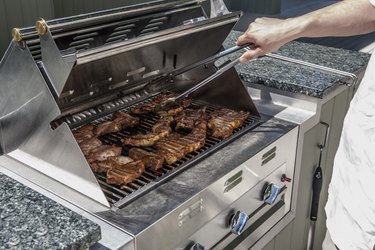Gas grills, stoves, water heaters and other appliances are designed by the manufacturer to burn either natural gas or propane, which is identified on the product label as LP gas (liquid propane). Natural gas gets piped into the house by the local utility company, while propane comes from a large refillable tank on the property or from a 5-gallon tank feeding the appliance.

Natural gas is fed at a smaller pressure than propane, so to get the same heating value (usually measured in BTUs), a natural gas orifice has to be smaller than a propane one. This suggests that you can convert a natural gas appliance to a propane one and vice versa by changing the orifice on the gas valve. The reality is more complicated, and for safety purposes, a conversion is best undertaken by a licensed gas specialist.
Video of the Day
Video of the Day
Propane Orifice vs. Natural Gas Orifice
The manufacturer creates the orifice in a gas valve by basically making a hole with a drill, and drill sizes are numbered from 75 to 1. The smallest hole — which is a little less than 3/64 inches — is 75, and the largest — 1/4 inch — is 1. You can find the number of BTUs that natural gas supplies at normal pressure by looking up the orifice size on a natural gas orifice size chart. Similarly, you can find the same data for propane by consulting a propane orifice size chart.
Propane and Natural Gas Are Supplied at Different Pressures
If you're considering converting between natural gas and propane, you can look up the combined data for both natural gas and propane on a natural gas propane conversion chart. You'll find that a 75-drill orifice supplies about 1,400 BTUs per hour with natural gas as the fuel and about 3,000 BTUs per hour with propane. That's a significant difference, and it's due to the different pressures at which the gases are supplied.
Cooktop burners typically supply about 40,000 BTUs per hour. A propane stove orifice size is about 0.082 inches (drill size 45), but the valve on a similar stove that uses natural gas needs an orifice that is almost 0.125 inches (drill size 35). If you want to convert from one to the other, you can replace the cap on the gas valve with one that has the correct orifice, but that's only part of the process.
What's Involved With a Propane to Natural Gas Conversion?
Besides changing the diameter of the gas valve orifice, a fuel conversion involves several other procedures. They include:
- Adjusting the gas valve to supply gas at the required pressure. If you have a unit such as a grill that is designed for conversion, the valve is adjustable, but that isn't true for all valves.
- Adding a pressure regulator to the system if you're converting from natural gas to propane.
- Changing the burners to ones with the correct orifice size.
If you don't make the necessary modifications to adjust the pressure, the consequences can be severe. Feeding natural gas through a system designed for propane could result in insufficient gas to light the burner, and unused gas could linger and cause an explosion. On the other hand, if you feed propane through a natural gas system, too much gas will flow, and the burner will overheat.
If your appliance is designed to be converted between natural gas and propane, it will be expressly designated as such. If so, you can purchase a model-specific kit to do the conversion. Follow the instructions carefully, or better yet, get a licensed technician to do it. If your appliance isn't designed for conversion, you should purchase a new one if you have to change the type of fuel you use.